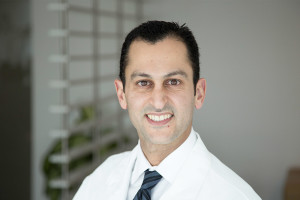Minimally Invasive Surgery (also known as MIS), is a term used to describe the types of spinal surgery where, instead of traditional open approaches, every effort is made to minimize the trauma to the tissues covering the spine (skin, soft tissues, muscle). This approach allows for faster recovery and less post-operative pain.
At K and B Surgical Center, we specialize in the latest MIS techniques and continue to push the frontiers of this emerging field — and minimize the invasive nature of spine surgery.
The spine surgery procedures we routinely perform include:
Microdiscectomy – In a microdiscectomy, a small portion of the bone over the nerve root and/or disc material from under the nerve root is removed to relieve neural  impingement and provide more room for the nerve to heal. The surgery is typically performed for a herniated lumbar disc and is actually more effective for treating leg pain (also known as radiculopathy) than lower back pain.
impingement and provide more room for the nerve to heal. The surgery is typically performed for a herniated lumbar disc and is actually more effective for treating leg pain (also known as radiculopathy) than lower back pain.
Impingement on the nerve root (compression) can cause substantial leg pain. While it may take weeks or months for the nerve root to fully heal and any numbness or weakness to get better, patients normally feel relief from leg pain almost immediately after the surgery.
A microdiscectomy is performed through a small (1 inch to 1 1/2 inch) incision in the midline of the low back.
First, the back muscles (erector spinae) are lifted off the bony arch (lamina) of the spine. Since these back muscles run vertically, they can be moved out of the way rather than cut.
The surgeon then enters the spine by removing a membrane over the nerve roots (ligamentum flavum), and uses either operating glasses (loupes) or an operating microscope to visualize the nerve root.
Often, a small portion of the inside facet joint is removed both to facilitate access to the nerve root and to relieve pressure over the nerve. The nerve root is then gently moved to the side and the disc material is removed from under the nerve root.
It’s important to note that since almost all of the joints, ligaments and muscles are left intact, a microdiscectomy does not change the mechanical structure of the patient’s lower spine (lumbar spine). This surgery is typically recommended for patients who have experienced leg pain for at least six weeks and/or have not found sufficient pain relief with conservative treatment such as oral steroids, anti-inflammatory medication, and/or physical therapy).
Balloon Kyphoplasty – This is a minimally invasive surgical procedure that can repair spinal fractures. The adult spine is a column of 33 bones that protects the spinal cord and enables a person to stand upright. Each bony segment of the spine is referred to as a vertebra (two or more are called vertebrae).
Having a spinal fracture means that one of the vertebrae has either cracked or collapsed. Like other bones in the body, the extent of the break can vary — from a hairline fracture of a complete collapse of the vertebral body.
When a bone breaks, localized swelling can occur, and pain is common. In the spine, swelling and misalignment can irritate adjacent tissue and nerves. Damage to even one vertebra can alter the alignment of the spine, upsetting the distribution of weight along the spinal column and setting the stage for another fracture.
Balloon Kyphoplasty can reduce or eliminate the back pain fro a spinal fracture, as well as restore vertebral body height and proper alignment of the spin. The procedure gets its name because a balloon is actually used to elevate the fractured vertebrae in order to return them to the correct position. The balloon creates a void or cavity that is then filled with a special cement to prevent further collapse.
gets its name because a balloon is actually used to elevate the fractured vertebrae in order to return them to the correct position. The balloon creates a void or cavity that is then filled with a special cement to prevent further collapse.
Anterior cervical discectomy and fusion (ACDF) – This is a minimally invasive procedure for surgically removing a herniated cervical disc or treating cervical degenerative disc disease.
It has been proved to be effective in relieving spinal cord or nerve pressure and alleviate the corresponding pain, weakness, numbness and tingling. Fusion surgery is almost always done at the same time as the discectomy in order to stabilize the cervical segment.
This surgery is done through the front of the neck instead of the back of it, for several reasons. First, it provides better access to the entire cervical spine. Secondly it results in less postoperative pain because approaching from the front of the neck provides a relatively uncomplicated pathway to the spine. After a skin incision is made in the front of the neck, only one thin vestigial muscle needs to be cut, after which anatomic planes can be followed right down to the spine. The limited amount of muscle division or dissection helps to limit postoperative pain following the spine surgery.
After a skin incision is made in the front of the neck, only one thin vestigial muscle needs to be cut, after which anatomic planes can be followed right down to the spine. The limited amount of muscle division or dissection helps to limit postoperative pain following the spine surgery.
While there are a number of potential risks and complications with ACDF surgery, the main postoperative problem most patients face is difficulty swallowing for 2 to 5 days due to retraction of the esophagus during the surgery.
Minimally Invasive Spinal Fusion – Spinal fusion surgery is a procedure to correct an unstable part of the spine by joining two or more vertebrae in an effort to decrease severe pain generated from the joint. At each level in the spine, there is a disc space in the front and paired facet joints in the back. Working together, these structures define a motion segment and permit multiple degrees of motion. Two vertebral segments need to be fused together to stop the motion at one segment, so that an L4-L5 (lumbar segment 4 and lumbar segment 5) spinal fusion is actually a one-level spinal fusion.
The surgery involves using bone graft to cause two vertebral bodies to grow together into one long bone. The supplementary bone tissue can be taken from the patient’s hip (autograft bone) during the spine fusion surgery, harvested from cadaver bone (allograft bone) or manufactured (synthetic bone graft substitute).
Spinal fusion is recommended for patients with degenerative disc disease, spondylolisthesis or other conditions such as a weak or unstable spine, scoliosis or other spinal deformity.
Dynamic Stabilization – This is a type of surgical procedure used to stabilize the lumbar spine in individuals with chronic lower back pain. It is an alternative to spinal fusion. One of the major drawbacks of spinal fusion is that even when all goes well and the spinal segments fuse, problems can arise down the road. Once two spinal segments have fused, extra stresses are transferred to the discs above and below the fusion. These segments tend to wear out more quickly, and this can necessitate additional surgical procedures down the road. This is especially problematic in younger, more active patients.
Dynamic stabilization surgery starts much like a typical spine fusion surgery. Once any disc problems have been addressed, the surgeon places a dynamic stabilization device to limit motion at the affected disc level. One commonly implanted device is called Dynesys, which uses screws to anchor to the vertebrae at two adjacent spinal levels. The screws are connected with rope (to prevent excessive tension) and plastic tubes (to prevent excessive compression).
Dynamic stabilization is a relatively new procedure and additional research is being done to determine its effectiveness as an alternative for patients with lumbar spinal problems.
Meet our Spine Surgery Experts
Parham Yashar, M.D.
Dr. Yashar has become a preeminent Neurosurgeon in the Los Angeles, San Fernando, and Santa Clarita areas since completing his fellowship and residency in 2012. With his broad experience, interest, and accomplishments in Spine, Brain, and Neuro-Interventional procedures, Dr. Yashar is a highly-skilled and exceptional Neurosurgeon, focusing on all aspects within the field of Neurosurgery, along with a special emphasis on both Spinal Surgery and Inte rventional Neurosurgical Procedures.
rventional Neurosurgical Procedures.
The son of an engineer and an LAUSD-based educator, Dr. Yashar attended the University of California, Los Angeles after graduating from the Medical Magnet program at Van Nuys High School. He completed his studies within the Department of Computer Sciences, receiving his Bachelor of Science degree (B.S.) with both High Honors and Departmental Distinction in Cybernetics, while simultaneously completing a Minor degree in Education Studies.
After graduating Summa Cum Laude from UCLA in 2000, Dr. Yashar moved to the Windy City, where he attended The Feinberg School of Medicine of Northwestern University and received his Doctorate of Medicine degree (M.D.). In 2005, Dr. Yashar, subsequently, completed his Surgery Internship at Montefiore Medical Center of the Albert Einstein College of Medicine, and then returned to his home city of Los Angeles, to complete his residency in Neurological Surgery at LAC+USC Medical Center/Keck School of Medicine. During his residency, he pursued and completed an internationally-recognized Endovascular Fellowship under the mentorship of Dr. L. Nelson Hopkins and Dr. Elad I. Levy, at the University at Buffalo (SUNY-Buffalo) in Upstate New York.
With his commitment to providing compassionate care and empathy to all of his patients, Dr. Yashar treats each patient individually, providing them with the necessary tools to direct their own care, and guiding them through each step of the treatment process, whether that includes non-surgical options, as well as both before and after any surgical procedure.
